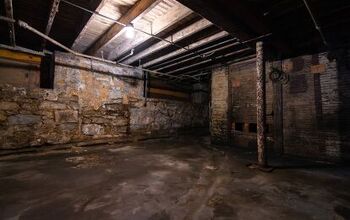What Is Basement Waterproofing? (Find Out Now!)

Cracked walls, peeling paint, and mold are all signs of water damage often seen in basements. If there’s water damage in your basement, then the clear solution is to waterproof it. But what is basement waterproofing, exactly, and what waterproofing methods can you choose between?
Basement waterproofing refers to various techniques and materials that protect the foundation and basement of your home from water damage. The three main types of basement waterproofing are interior waterproofing, exterior waterproofing, and drainage systems. A combination of all waterproofing methods is most effective, but exterior waterproofing is often necessary to address the underlying issues.
Do You Need Foundation or Basement Waterproofing?
Get free, zero-commitment quotes from pro contractors near you.

What Is Waterproofing?
In general, waterproofing refers to the process of making a structure waterproof. The goal is to prevent the negative effects that come with long-term water exposure and flooding. Waterproofing a house involves taking multiple steps to prevent water from coming in.
You can waterproof the roof, siding, and basement of your home. To waterproof a basement, there are various techniques and materials to consider. A few common tools for waterproofing involve sealants, sump pumps, and drains.
Building codes often require houses built at or below ground level to be waterproofed. Waterproofing is especially important for any structure in an area with a high water table or where groundwater builds up.
What Are The Benefits Of Waterproofing?
Waterproofing is crucial to protect the structural integrity of your home, and a waterproof basement keeps your home’s interior dry. It also reduces humidity and prevents issues with mold and mildew. This makes for a healthier environment overall, since allergies and asthma can be exacerbated by mold and humidity.
Water damage accounts for around 20% of insurance claims made by homeowners. Waterproofing can result in a huge reduction in the cost of your insurance claims. Plus, if you waterproof your basement, you’ll enjoy lower heating and air conditioning costs as well.
What Are The Main Methods Of Basement Waterproofing?
There are three main methods for basement waterproofing: interior waterproofing, exterior waterproofing, and drainage systems.
Interior Waterproofing
Interior waterproofing is typically considered the easiest and most affordable option. However, that doesn’t mean it’s always the best choice.
Interior waterproofing doesn’t address the underlying problems that are causing the water damage. These problems are usually outside. However, interior waterproofing is still an effective choice in some cases.
The process usually consists of filling cracks and holes and applying a waterproof sealant to your basement. In some cases, drainage systems and sump pumps will be installed as well.
When Is Interior Waterproofing The Best Choice?Concrete or masonry walls that are structurally sound are the best candidates for interior waterproofing. Often, homeowners with landscaping around the foundation of their home opt for interior waterproofing to avoid damaging the landscaping.
If your home only has minor dampness and condensation is the main source of wetness, waterproof coatings will be effective. But if you have major leaks, you’ll need to take more drastic measures.
Exterior Waterproofing
Waterproofing from the outside is the most effective method to avoid foundation erosion and chronic moisture issues. Ideally, exterior waterproofing is completed during construction. Otherwise, it’s an intrusive and labor-intensive process that requires heavy machinery.
Exterior waterproofing is the only method that the US International Building Code recognizes. The IBC states that it is an adequate manner of preventing structural damage caused by long-term water exposure.
What Is The Exterior Waterproofing Process?The waterproofing process begins with the excavation of the soil around your house’s foundation. After all the soil has been removed, the walls are all power washed. Then, a waterproof sealant is applied. The final step is to add drainage tiles along the bottom of the foundation of the house.
An additional component to exterior waterproofing is the gutter system. Properly installed gutters direct rainwater away from your house’s foundation. Your gutter system works together with the rest of the exterior waterproofing process to prevent water damage to your home.
Drainage Systems
Often, faulty drainage systems are the underlying cause of moisture in basements. Well-maintained interior drainage systems can be very effective in preventing water damage and wetness in your basement.
One common interior drainage system is called the French drain. To install a French drain, professionals dig a trench along the interior perimeter of the basement floor. Then, they install a drain and sump pump to move the water out of the basement.
Related Questions
Is basement waterproofing covered by insurance?
Basement waterproofing systems are not usually covered by homeowners insurance. However, in the case of basement flooding and damage, your insurance is likely to cover the cost of cleanup. One of the benefits of waterproofing is that it can significantly cut back on the cost of insurance claims.
Is basement waterproofing worth it?
Basement waterproofing is considered a valuable home repair by most experts. Your return on investment will depend on multiple factors, but overall, waterproofing is worth the expense.
Is basement waterproofing necessary?
It’s necessary to waterproof your basement if you want to avoid water damage. If the basement is not part of your living space, applying vapor proofing to the ceiling above may be sufficient. But if you have a finished basement, waterproofing is a must.
Do You Need Foundation or Basement Waterproofing?
Get free, zero-commitment quotes from pro contractors near you.

The Bottom Line
- Waterproofing is the process of protecting a structure from water damage. You can waterproof almost any part of your house, including the roof, siding, and basement.
- It’s often necessary to waterproof your basement to protect the foundation’s structural integrity.
- Interior waterproofing is more convenient and inexpensive, but it doesn’t address the underlying issues that cause water damage. It consists of filling in cracks and holes and applying sealant.
- Exterior waterproofing is the only US IBC-approved method for preventing structural damage. It involves excavating all the soil around the house’s foundation and applying sealant and drainage tiles. It’s ideal to do exterior waterproofing during the construction process, rather than after, since it will destroy the surrounding landscaping.
- Drainage systems like sump pumps are a great addition to interior waterproofing. They collect the water in the basement and move it out so that it doesn’t cause damage.

With a lifelong passion for writing plus strong enthusiasm for home improvement and DIY projects, joining the team at Upgraded Home was an easy choice. Jessica Allen likes to share helpful information with current and aspiring homeowners. Aside from writing, Jessica loves doing yoga, playing the piano, and dabbling in graphic design.
More by Jessica Allen



























